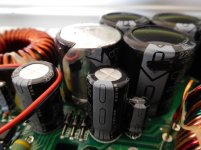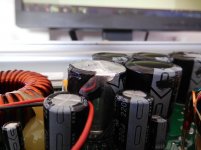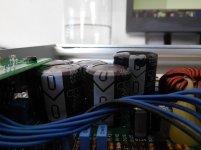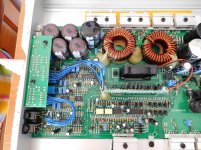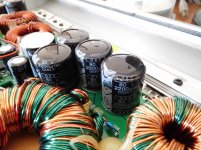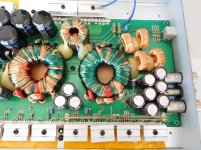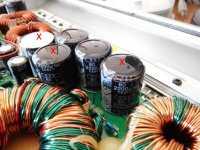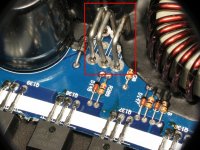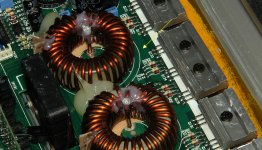Hello everyone, I'm a new member and it's my pleasure to be here.
I am from Greece I am 27 years old and I have studied Electronics in Secondary Education.
80% of my car audio theoretical knowledge I owe it to Mr Babin Perry - car audio basic.
My hobby and the work I'm doing as Freelance since 2011 is car audio.
forgive me for my English because I do not know well to write, i use the google translation.
The story of my problem starts somewhat like that.
I have a car amp with a name PLANET AUDIO TT2250D and recently
i noticed that the loudspeaker's movement did not match well with the rhythm of the music and the loudspeaker's suspension seemed almost uncontrollable In relation to the intensity of the music with the amplifier settings to a minimum.
The next day After a 5 minutes of loud music a strange smell captured the car and suddenly the amplifier stopped playing, (The smell came from the amplifier).
And I noticed that the Protect and Power led of the amplifier was off.
I immediately took the multimeter into my hands i set it to DC Volts and measured the power supply at the amplifier input and the multimeter showed 4VDC (black probe to input GND terminal) (Red probe to power input B+ terminal).
Then I measured the Remote terminal with Head unit open and the voltage It was Well below 12VDC, If I remember well under 7VDC
(All measurements were made with On and Off Head unit And the power supply voltage of the amplifier remained approximately the same).
Then I removed the power ground and remote cables from the amplifier and measured them out.
Power wires (Black prob to the ground wire and red prob to B+ wire) V=12.3V).
Remote wire was 11.93VDC (black prob to Ground wire red prob to Remote wire with head unit open).
The (main power wire), (power connection to battery ), (main Fuse), (Ground wire), (Ground connection) , (Remote wire) , (Subwoofer and subwoofer wires are good).
After the measurements I connected the amplifier cables and I activated the amplifier again and i noticed that the protect led comes on (on normally bright) and then go off (off dimm delay 2 seconds).
So after the check on the car, I decided to take the amp and check it at home and look inside the amplifier for any obvious damage.
The first thing I saw when I removed the amplifier cap was that there was a lot of fluid on the amplifier cap and inside of the amplifier from the large five 2200μF electrolytic capacitors and one of the five 2200μF electrolytic capacitors is for sure inflated, the horrible smell came from these liquids.
Then i got the multimeter in my hands and i look for any Short circuit in the legs as i have learned on the website (car audio basic) in the power supply and output tranistors and i did not find any short in the legs in each one separately.
I did not know what else to do and Finally i decided to replace these five capacitors with another brand, but with the same characteristics.
After many hours of work the new capacitors were installed. And with a very positive thought I decided to power the amplifier.
The power i used for the amplifier was from a computer power supply and the signal from Output of the computer headphones.
Before i power the amplifier i put a 7A fuse in line with the power B+ wire and then i turned on the power supply.
The amplifier normally operated with a 2.5-3 A peak current with no signal this time ( Ptotect led on 4sec then off) then (Green led on Stable and bright).
The only thing i noticed during the power process is that the fan was working at a slightly higher RPMS than it should be and the consumption current was not completely stable and played from 2.3A, 2.6A, 3A and after 1.5 minutes the fan returned to normal RPMS.
Then i closed the amplifier and i put the signal and connected a 4 ohm speaker load to the amplifier channel and the amplifier played normally without distortion and for at least 20 minutes without any problems.
Finally i decided to install the amplifier again in the car and after 5 minutes of loud music and low voltage in the car the amplifier turned off with the same symptoms as before except the smell.
I apologize for the many details but i really want you to understand my problem so you can help me as much as possible without getting tired of me.
🙁
I am from Greece I am 27 years old and I have studied Electronics in Secondary Education.
80% of my car audio theoretical knowledge I owe it to Mr Babin Perry - car audio basic.
My hobby and the work I'm doing as Freelance since 2011 is car audio.
forgive me for my English because I do not know well to write, i use the google translation.
The story of my problem starts somewhat like that.
I have a car amp with a name PLANET AUDIO TT2250D and recently
i noticed that the loudspeaker's movement did not match well with the rhythm of the music and the loudspeaker's suspension seemed almost uncontrollable In relation to the intensity of the music with the amplifier settings to a minimum.
The next day After a 5 minutes of loud music a strange smell captured the car and suddenly the amplifier stopped playing, (The smell came from the amplifier).
And I noticed that the Protect and Power led of the amplifier was off.
I immediately took the multimeter into my hands i set it to DC Volts and measured the power supply at the amplifier input and the multimeter showed 4VDC (black probe to input GND terminal) (Red probe to power input B+ terminal).
Then I measured the Remote terminal with Head unit open and the voltage It was Well below 12VDC, If I remember well under 7VDC
(All measurements were made with On and Off Head unit And the power supply voltage of the amplifier remained approximately the same).
Then I removed the power ground and remote cables from the amplifier and measured them out.
Power wires (Black prob to the ground wire and red prob to B+ wire) V=12.3V).
Remote wire was 11.93VDC (black prob to Ground wire red prob to Remote wire with head unit open).
The (main power wire), (power connection to battery ), (main Fuse), (Ground wire), (Ground connection) , (Remote wire) , (Subwoofer and subwoofer wires are good).
After the measurements I connected the amplifier cables and I activated the amplifier again and i noticed that the protect led comes on (on normally bright) and then go off (off dimm delay 2 seconds).
So after the check on the car, I decided to take the amp and check it at home and look inside the amplifier for any obvious damage.
The first thing I saw when I removed the amplifier cap was that there was a lot of fluid on the amplifier cap and inside of the amplifier from the large five 2200μF electrolytic capacitors and one of the five 2200μF electrolytic capacitors is for sure inflated, the horrible smell came from these liquids.
Then i got the multimeter in my hands and i look for any Short circuit in the legs as i have learned on the website (car audio basic) in the power supply and output tranistors and i did not find any short in the legs in each one separately.
I did not know what else to do and Finally i decided to replace these five capacitors with another brand, but with the same characteristics.
After many hours of work the new capacitors were installed. And with a very positive thought I decided to power the amplifier.
The power i used for the amplifier was from a computer power supply and the signal from Output of the computer headphones.
Before i power the amplifier i put a 7A fuse in line with the power B+ wire and then i turned on the power supply.
The amplifier normally operated with a 2.5-3 A peak current with no signal this time ( Ptotect led on 4sec then off) then (Green led on Stable and bright).
The only thing i noticed during the power process is that the fan was working at a slightly higher RPMS than it should be and the consumption current was not completely stable and played from 2.3A, 2.6A, 3A and after 1.5 minutes the fan returned to normal RPMS.
Then i closed the amplifier and i put the signal and connected a 4 ohm speaker load to the amplifier channel and the amplifier played normally without distortion and for at least 20 minutes without any problems.
Finally i decided to install the amplifier again in the car and after 5 minutes of loud music and low voltage in the car the amplifier turned off with the same symptoms as before except the smell.
I apologize for the many details but i really want you to understand my problem so you can help me as much as possible without getting tired of me.
🙁
All the integrated circuits on the amplifier board without the small board with the fan are : (072D JRC 3028B), (13600D JRC A3003B), (K0309 KPC127 GR), (KA3525A),(KIA 393P 318).
The drivers for the low-side FETs often fail. When this happens, it causes the low-side rail voltage to go too high (sometimes double) and it will destroy the low-side rail caps.
Measure the DC voltage on the low-side (touch the shunt resistors with the meter probe). Before signal is applied, the high and low side will likely be of the same magnitude. When audio is applied, the low side rail voltage is likely to change significantly.
Measure the DC voltage on the low-side (touch the shunt resistors with the meter probe). Before signal is applied, the high and low side will likely be of the same magnitude. When audio is applied, the low side rail voltage is likely to change significantly.
Internal images from the amplifier.
Attachments
Hello Mr Perry Babin thank you very much for your response, please can you become a little more specific?
Where i put the multimeter terminals red prob, black prob;
Forgive me but i do not understand the terms shunt resistors, high and low side, low-side FETs where are they in the board?
The driver That you mentioned is the drivers transistors where drive the square wave signal into the gate resistors?
Please do patience, I have not again deal with repair of amplifier devices
Where i put the multimeter terminals red prob, black prob;
Forgive me but i do not understand the terms shunt resistors, high and low side, low-side FETs where are they in the board?
The driver That you mentioned is the drivers transistors where drive the square wave signal into the gate resistors?
Please do patience, I have not again deal with repair of amplifier devices
Black on negative speaker terminal.
The wire-type components in the red square are the shunt resistors.
Make a small scratch through the solder mask at the point of the yellow arrow to measure the positive rail voltage.
The wire-type components in the red square are the shunt resistors.
Make a small scratch through the solder mask at the point of the yellow arrow to measure the positive rail voltage.
Attachments
Hello the DC voltage on this point is minimum 64.6V most of the time and some time It goes to maximum 67.6V and the amplifier for some strange reason it works normally with protect led Off and Power led on
Are the solder connections on Q124, Q125 on the driver board in good condition?
Those transistors can sometimes function intermittently.
Those transistors can sometimes function intermittently.
Q124 and 125 are supposed to be working in parallel. If they are not the same temperature, one has failed. I'd replace both. Install them so that the body of the transistor is very near the blades of the fan (see previous photo) so that they can have more airflow over them. This will also help prevent further damage to the board.
This has been covered many times. If you want to see other repairs like this, search the forum for:
Q124 Q125
This has been covered many times. If you want to see other repairs like this, search the forum for:
Q124 Q125
Q124, 125, Q126, Q116, Q118, Q110, Q111, Q112 are the only ones are very hot, Especially the Q124, Q116 Q112 I can barely touch my finger over them over 2 seconds. The soldering and the paths of the driver board are fine.
Okay, if I find the new parts tomorrow I will replace them, after replacing these parts I should look at something else;
In many cases, replacing Q124/5 and the blown low-side rail caps is all that needs to be done. These amps have a dozen other common problems. Search as I suggested and you'll see other problems mentioned.
I changed the low-side rail inflated capacitors with new in first time , but then the amplifier closed again with same symptoms , the capacitors now do not visually appear to have a problem, how can I see that the capacitors have no problem Except for visual inspection?
Last edited:
Thank you very much, sir, I am grateful for your help. Soon I will buy from you the full amplifier repair tutorial, So that I can become a good technician.
Maybe you can trace the signal stop with this item
Billm Audio Troubleshooting your amp with audio signal tracing
Billm Audio Troubleshooting your amp with audio signal tracing
- Status
- Not open for further replies.
- Home
- General Interest
- Car Audio
- Dead PLANET AUDIO TT2250D amplifier with inflated capacitors
